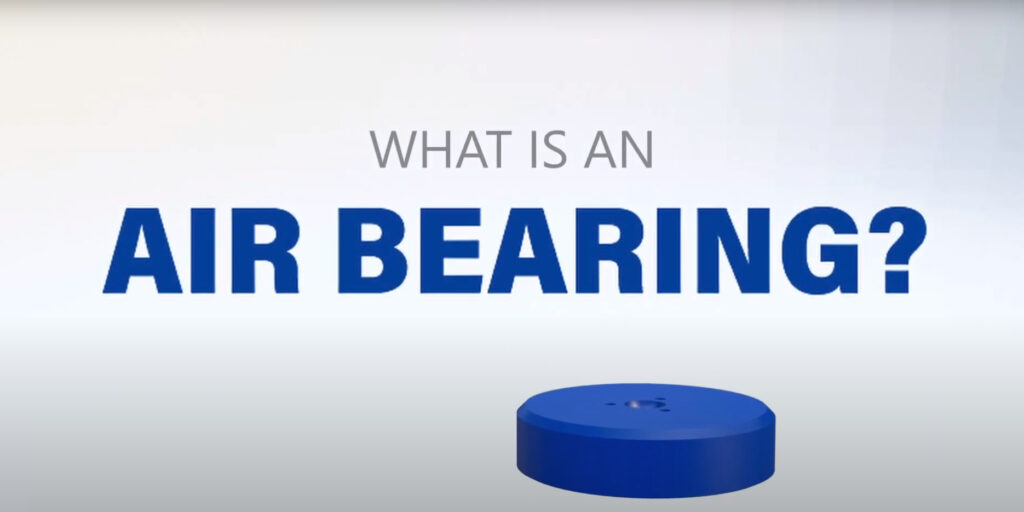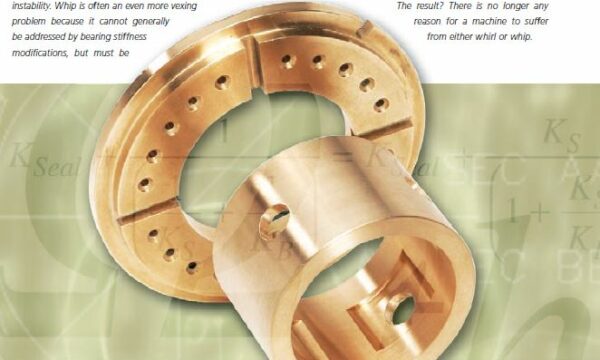For supporting rotating artifacts such as natural gas turbines, compressors, turboexpanders, pumps, motors and more, the choice of bearings and motion solutions can be daunting. Despite the leaps and bounds made in contact bearings technologies; new coatings, lubricants and more, these systems are still bound by tribological effects, and eventually wear down. Fluid film bearings offer a solution to this problem. Broadly divided into hydrostatic and hydrodynamic designs, these bearings make use of a fluid medium between the bearing faces, where shear within the fluid acts as the contacting motion “surface”. While these products can provide benefits over fully contact based solutions, their own drawbacks are considerable. Only externally pressurized porous media from New Way Air Bearings ®, a specialized subset of hydrostatic fluid film bearings, offer the stability, resiliency and capacity required for the next generation of high speed turbomachinery applications.
Hydrostatic Bearings
Hydrostatic bearings use an externally pressurized medium (usually air, water or most commonly oil), to separate the bearing faces. They can provide low friction, high damping and high load capacity, but at the cost of filtering their fluid for particulates, high power consumption from pumping equipment, and “pneumatic hammer” instabilities. Orifice based air bearing solutions fall into this category as well, using machined grooves or slots in a steel face to create an air gap, but they are equally susceptible to the above issues, and are even more dangerous in a loss of power scenario.
Hydrodynamic Bearings
Instead of an external pressure source, hydrodynamic bearings use the pressure generated by relative speeds between the journal and rotating bearing to pressurize their fluid medium in a wedge shaped groove between the faces. Oil is commonly used as well, but a form of air bearings called a foil bearing may be used as well. Viscous effects pull gas into the bearing gap, pressurizing a foil journal lining. Once at operational RPM, the foil bearing is a fully contained, non contact solution. Though this appears to be a fully ideal solution, on startup and slow down, the bearing still contacts the inner journal, producing wear and tear which must be accounted for. Additionally, foil bearings must be designed to their specific applications.
The Porous Media Difference
A unique subset of hydrostatic bearings, New Way’s porous media air bearings use our proprietary porous media substrate to create a micro thin layer of air. Because the entire bearing face is equally pressurized and the torturous passageways of the microperforated surface resist rapid changes in pressure, what results is an even layer of air which is highly resistant to the changes in pressure (thus immune to pneumatic hammer effects and fluid layer collapse), highly stiff, and with a positive correlation between stiffness and damping thanks to the squeeze film effect. Porous media bearings are fully non contact solution at all speeds, and because the microperforated surface of the bearing removes contaminants down to ISO Class 1 cleanroom standards, porous media bearings do not require additional particulate filtration systems beyond standard air cleaning measures on the pump side.
Replacing Fluid Film Bearings With Porous Media
Because air bearings are modular, designed for high speed, and easily disperse heat through the air gap, they are well adapted to replacing fluid film bearings in turbomachinery and rotating artifact applications. Oftentimes when OEM’s, system integrators and turbomachinery operators express interest in switching to porous media bearings, their primary concerns relate to interoperability, and the ability to tune air bearings to the specific rotordynamic characteristics of your artifact. For compatibility, porous media air bearings are easily retrofitted into numerous existing motion systems. We offer drop in ready solutions for some industries, and we offer turnkey engineering to upgrade your system. For dynamic tuning, we also offer in-house rotordynamic analysis, allowing us to identify the proper bearings and tune their performance to meet your exact specifications.
A Product Line Made For Turbomachinery
New Way Air Bearings has a wide array of products to meet your fluid film bearing needs. For balancing operations, our balance bearings are specially designed to synchronize and average motion errors, completely eliminating axial force errors in measurement. Our radial air bearings can be produced for any sized shaft, and thrust bushings may be used in concert to axially constrain a rotating artifact.
Contact Us
Want to learn more about upgrading from fluid film bearings, or do you already have an application in mind? Please contact us, and our dedicated engineering sales team will reach out to you to understand your specific needs.



